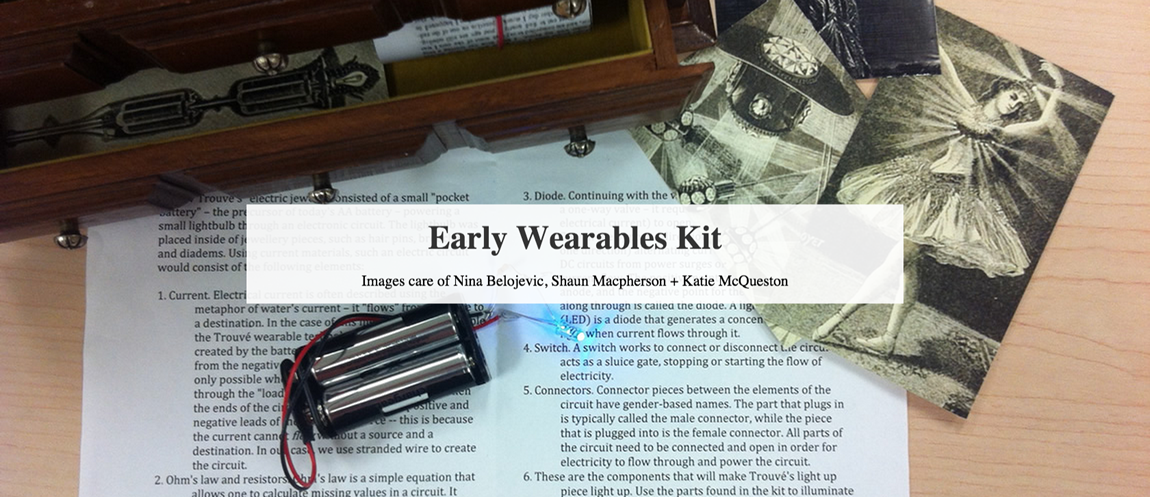The Maker Lab’s Kits for Cultural History team spent the 2013-14 year prototyping DIY kits around historically relevant technologies, including wearables, wire recorders, and videogames. During HASTAC 2014 at the Ministry of Culture (pictured above) in Lima, Peru, Jentery Sayers and I gave a talk titled, “Making a Kit for Cultural History,” which walked our audience through our conceptual framework for the kits, our approach to making them, and our findings thus far. Here’s the slidedeck from the presentation, and a key slide (“Research Implications”) from it is below. (To navigate the slidedeck, just use your space bar or arrow keys.)
As Shaun Macpherson and I argue elsewhere, in “Publish This Kit” Part I and Part II, the kits afford a form of tacit engagement that encourages audiences to reassemble historical technologies using current materials in order to better understand the material relationships between culture and media.
The presentation Jentery and I gave at HASTAC 2014 outlined the content of a typical kit, the principles of the kits project, and an example kit. Each kit will contain a combination of instructions and parts required for assembly. The instructions will not only provide an overview of actions required to reassemble a historical device; they will also describe how specific elements work as well as unpack how those elements are culturally embedded. Furthermore, the kits will contain contextual materials in print and/or digital formats. By developing kits that can be accessible in various formats—as both bits and atoms, if you will—we can circulate them in multiple ways: for example, as web-based scholarship, as physical objects to be delivered by post, and as elaborate kits that could be acquired through GLAM (Gallery, Library, Archive, and Museum) institutions, such as science and technology museums. This variety should also spark an array of counterfactual interpretations and prompt some serious speculation. (Curious about counterfactuals? Check out Kari Kraus’s research.)
Our decisions to assemble the kits this way are based on several key principles. We want to create scholarship that expands beyond more academically established forms of communication (such as writing) and uses the very materials, objects, and media it discusses to make a scholarly argument. By encouraging hands-on engagement with these materials, we hope that audiences will develop a material understanding of how certain mechanisms work and how their functionality is culturally significant. By situating the materiality of these devices in a historical context, the kits offer a way to politicize the role of forensics and archaeology in media studies, prompting audiences to better understand how the evidentiary value of objects is imbued with social and cultural significance. Here, the question is not what is inherently stored in a given device or medium, but rather how it got there in the first place and under what assumptions.
As an example of what such a kit might look like, at HASTAC 2014 we described our early wearables kit, which is based on the electronic jewellery pieces created by the nineteenth-century French engineer, physician, chemist, and scientific instrument maker, Gustave Trouvé. Trouvé designed intricate jewellery pieces that ranged from a light-up bird hairpin to a soldier beating a drum, a skull gnashing its teeth, a rabbit playing on a bell with drumsticks, and many more. The trick that set the movement going was no switch or button; it was simply turning the battery on its side or upside down. The skull and rabbit stick-pins worked for nine hours every day over six months and were still going even then. However, only a few of these pieces survive, since Trouvé was unable to find craftsmen who could make such small objects with the precision required and thus only created a small number of prototypes.
The early wearables kit replicates—but does not restore—these mechanisms by using materials and technologies readily available today. This year we have been working on a simple light-up filigree hairpin and a gnashing skull, which are being designed as 3D models to be fabricated using CNC milling machines, 3D printers, and laser cutters at UVic. These models and objects, together with other necessary components (e.g., LEDs, wires, and motors), will be included in an early wearables kit. While not wholly accurate in terms of its historical specificity, this approach in many ways makes possible what wasn’t in the nineteenth century, including the possibility of designing intricate jewellery through digital design and computer-controlled precision machinery.
The kits’ components will also explore the cultural contexts and discursive elements of early wearables. These materials work in a pedagogical manner by helping audiences assemble a circuit or mechanism while situating the wearable in history. For instance, a description of electrical current may also explain how the “hard” and “soft” distinctions between electricity and the materials that conduct it are informed by late nineteenth-century gender politics. The construction of the circuit may also make note of “male” and “female” connector pieces and other gendered terminology, and the design of the jewellery piece itself could speak to how the original devices were engineered to be exhibited on women’s bodies, rendering these bodies display objects for male innovation. Such instructions invite audiences to closely read the different materials and consciously work through the kit. In other words, the kits employ a humanities approach to technical literacy (or tinkering) that promotes reflexive building.
Post by Nina Belojevic, attached to the KitsForCulture and HASTAC projects, with the news, physcomp, and fabrication tags. Images for this post care of Nina Belojevic and Jentery Sayers.



